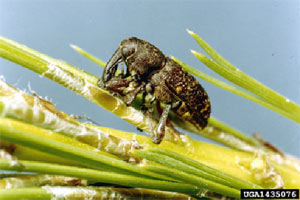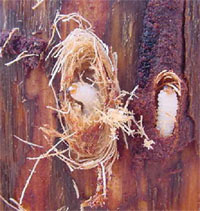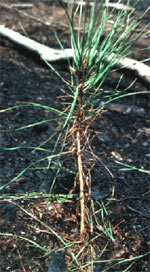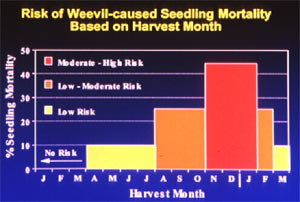Importance: Pales weevil (Hylobius pales) and pitch-eating weevil (Pachylobius picivorus) can cause considerable losses to pine seedlings in Texas. Adults commonly feed on the cambium of one-year-old seedlings but will also feed on and destroy older seedlings and saplings. When there are large population buildups, 50-80% or more of seedlings may be destroyed. Weevil problems in Texas tend to be localized on scattered tracts.

Identification: Weevils are robust, hard-shelled beetles characterized by a rigid and prominent snout with tiny chewing mouthparts at the tip. Pales weevil and pitch-eating weevil are similar in appearance. Adults are black or nearly so, and often speckled with whitish markings. They are ¼” to ⅓” long. Larvae of both species are legless, approximately ¼” long, and white with a dark brown head capsule. Pupae are white and the typical weevil beak is distinctive. Eggs are very small and white.

Signs of Attack: Adults typically eat patches of bark anywhere on the stem, branches, and primary roots of one-year old and older seedlings. At moderate population levels, feeding may be extensive enough to girdle the stem and/or root collar causing a seedling to quickly wither and die. If weevils are abundant, they may remove all of the bark, leaving a seedling with green needles (they eventually turn red) and a white stem. Examination of pine stumps and large roots in the area may reveal larvae, pupae or oval fibrous covered (nest-like) pupal cells. On sandy sites, the weevils may burrow into the soil to feed on and below the root collar. In this situation, seedlings may die with no observable above-ground signs of damage. Below-ground feeding is rare on clay soils.

Life Cycle: Most damage by the pales and pitch-eating weevils occurs in spring (March and April), but some damage may occur in the fall. Adults are attracted to the odor of freshly cut pine stumps, scorched pines, or dying trees, and feed on tender bark of nearby seedlings. Eggs are deposited in the root bark of stumps and trees. Larvae hatch in one to two weeks, and feed primarily inWeevil life cycle roots for six to eight weeks. Larval galleries are packed with granular borings and when larvae are mature, they construct a shallow fibrous covered pupa cell in the sapwood. The pupa stage lasts two to four weeks, depending on the temperature. New adults may feed on seedlings before flying to other cutover or recently burned stands. The weevils feed at night or on cloudy days. On sunny days, they may be found in litter or soil near damaged seedlings.

Control: Under forest conditions, the most practical and inexpensive method of control is to delay planting for 6 to 9 months following harvest. Also, consider the following guidelines:
- If no pine has been cut from an area to be planted, there will be no weevil problem.
- If a pine stand is cut before June 1 and the area will be planted during the following winter, there will be no weevil problem.
- If 3 cords of pine/acre or less are cut from an area or pushed down during site preparation after June 1, losses should be less than 5% if the area is planted during the following winter.
- If 5 to 10 cords/acre of pine are cut or pushed down during site preparation, losses may be up to 25% if the area is planted the following winter.
- If over 10 cords of pulpwood or 5,000 board feet of sawtimber are cut or pushed down during site preparation after June 1, use treated seedlings or plant seedlings next year.
Chemical Control: Forest control: When the interval from harvest to planting is less than 6 months, seedlings treated in the nursery with the insecticide Arctic® (permethrin) should be used. Arctic® can also be applied after planting. Shade tree control: Hand pick and destroy weevils or spray selected trees with Arctic®. Always follow label directions.
(HAP/June 2011)
Photo Credits: H. A. (Joe) Pase III and Don Grosman, Texas A&M Forest Service; Clemson University - USDA Cooperative Extension Slide Series, www.forestryimages.org